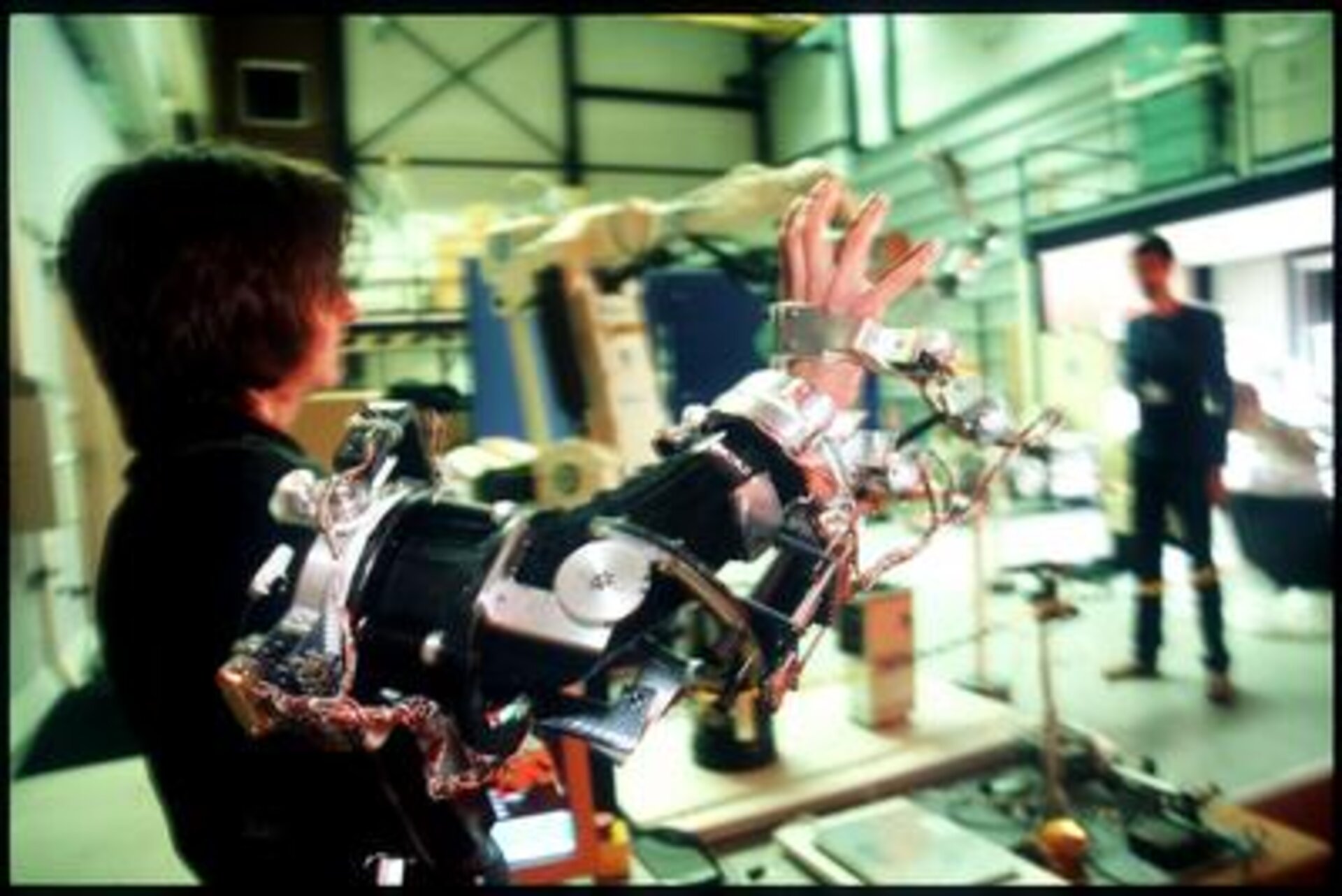The ESA Exoskeleton
The ESA Human Arm Exoskeleton has been developed to enable in-space force-feedback telemanipulations with redundant robotic arms. The target application of the ESA Exoskeleton is telemanipulation of astronaut-like robots, operating in a remote harsh environment, by robot-untrained operators placed in a comfortarble (but gravity-less) environment. Example of this applications are:
- telemanipulation of an EUROBOT system operating outside the International Space Station, from inside the pressurised modules.
- telemanipulation of agents working on the Martian surface from an orbiting Martian spacecraft
Making Robot Use Easy

The ESA exoskeleton is a wearable human-machine-interface that allows to operate a remote robot arm in the most intuitive way: Haptic Telepresence. Telepresence is defined as a human/machine system in which the human operator receives sufficient information about the teleoperator and the task environment, displayed in a sufficiently natural way, that the operator feels physically present at the remote site. Haptic Telepresence adds to telepresence the sense of touch. With Haptic Telepresence anybody can operate a robot without training.
Exoskeleton Design Requirements
Following the requirements and constraints of the space applications, the exoskeleton has been designed to:
- be a transportable and wearable system
- require no attachment to external structures during operation
- produce force feedback just on the human arm joints and not on the whole body
- allow the full range of human arm motion
- have a total mass below 10kg.
- adjust to the 5th to 95th percentile of male population
Innovative Design
A major innovation of the ESA Exoskeleton is in its kinematics.
There is no attempt to imitate the human shoulder, elbow or wrist kinematics.
On the contrary, an alternative kinematics chain offering the same freedom of motion is bridged over the human joints.
This chain and the human joints form a closed kinematics loop that:
- For the shoulder begins at the sternum, bridges over the claviscapular and glenohumeral joints and ends in the middle of the humerus bone.
- For the elbow begins at the middle of the humerus bone and ends at the middle of the forearm.
- For the wrist starts at the middle of the forearm and ends in the middle of the palm.
Even though the kinematics of the exoskeleton and the human arm are different, any posture of the human joints (i.e. shoulder-girdle, elbow, ellipsoid wrist joint) can be univocally determined by the corresponding posture of the exoskeleton.
Advantages of a this innovative kinematics are:
- The weight of the exoskeleton is not carried by the arm but by the thorax (hence the spine).
- The complete range of human shoulder, elbow and wrist motion is still possible. See a video on the allowed range of motion
- The exoskeleton joints are simpler and smaller.
- No major alignment between the human joints and any of the exoskeleton joints is needed.
- The Exoskeleton is a wearable system, that can be easily transported and worn. See a video on the wearing of the Exoskeleton
Exoskeleton and EUROBOT

The ESA Exoskeleton is ideal means to teleoperate the EUROBOT system. The exoskeleton is in fact integrated in the Eurobot Testbed, where successuflly demonstrates its effectiveness.
References
- The ESA Human Arm Exoskeleton for Space Robotics Telepresence, A. Schiele, G. Visentin, 7th International Symposium on Artificial Intelligence, Robotics and Automation in Spacei-SAIRAS 2003, NARA, Japan, May 19-23, 2003
- Sheridan, T.B. (1992). Musings on telepresence and virtual presence. Presence: Teleoperators and Virtual Environments 1, 120-125


